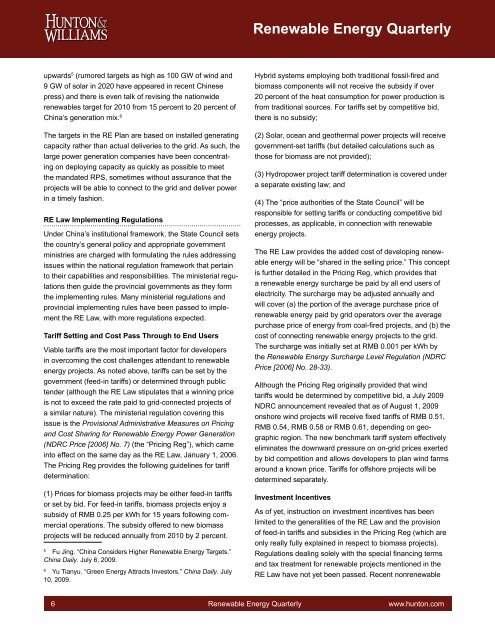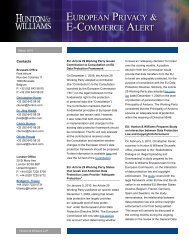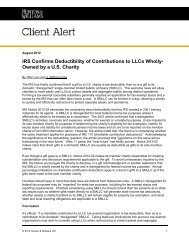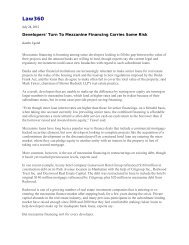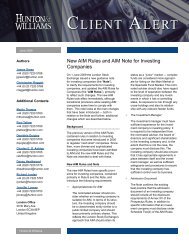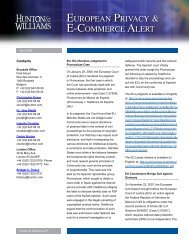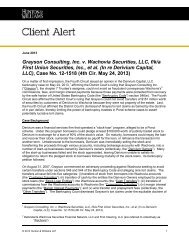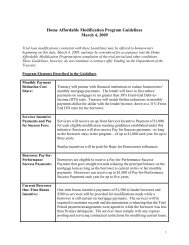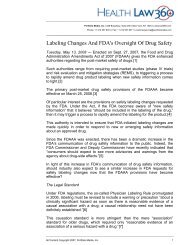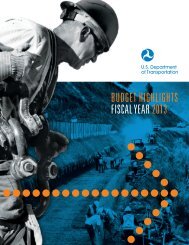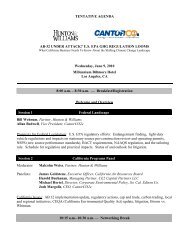Hunton & Williams Renewable Energy Quarterly, September 2009
Hunton & Williams Renewable Energy Quarterly, September 2009
Hunton & Williams Renewable Energy Quarterly, September 2009
Create successful ePaper yourself
Turn your PDF publications into a flip-book with our unique Google optimized e-Paper software.
<strong>Renewable</strong> <strong>Energy</strong> <strong>Quarterly</strong><br />
upwards 5 (rumored targets as high as 100 GW of wind and<br />
9 GW of solar in 2020 have appeared in recent Chinese<br />
press) and there is even talk of revising the nationwide<br />
renewables target for 2010 from 15 percent to 20 percent of<br />
China’s generation mix. 6<br />
The targets in the RE Plan are based on installed generating<br />
capacity rather than actual deliveries to the grid. As such, the<br />
large power generation companies have been concentrating<br />
on deploying capacity as quickly as possible to meet<br />
the mandated RPS, sometimes without assurance that the<br />
projects will be able to connect to the grid and deliver power<br />
in a timely fashion.<br />
RE Law Implementing Regulations<br />
Under China’s institutional framework, the State Council sets<br />
the country’s general policy and appropriate government<br />
ministries are charged with formulating the rules addressing<br />
issues within the national regulation framework that pertain<br />
to their capabilities and responsibilities. The ministerial regulations<br />
then guide the provincial governments as they form<br />
the implementing rules. Many ministerial regulations and<br />
provincial implementing rules have been passed to implement<br />
the RE Law, with more regulations expected.<br />
Tariff Setting and Cost Pass Through to End Users<br />
Viable tariffs are the most important factor for developers<br />
in overcoming the cost challenges attendant to renewable<br />
energy projects. As noted above, tariffs can be set by the<br />
government (feed-in tariffs) or determined through public<br />
tender (although the RE Law stipulates that a winning price<br />
is not to exceed the rate paid to grid-connected projects of<br />
a similar nature). The ministerial regulation covering this<br />
issue is the Provisional Administrative Measures on Pricing<br />
and Cost Sharing for <strong>Renewable</strong> <strong>Energy</strong> Power Generation<br />
(NDRC Price [2006] No. 7) (the “Pricing Reg”), which came<br />
into effect on the same day as the RE Law, January 1, 2006.<br />
The Pricing Reg provides the following guidelines for tariff<br />
determination:<br />
(1) Prices for biomass projects may be either feed-in tariffs<br />
or set by bid. For feed-in tariffs, biomass projects enjoy a<br />
subsidy of RMB 0.25 per kWh for 15 years following commercial<br />
operations. The subsidy offered to new biomass<br />
projects will be reduced annually from 2010 by 2 percent.<br />
5<br />
Fu Jing. “China Considers Higher <strong>Renewable</strong> <strong>Energy</strong> Targets.”<br />
China Daily. July 6, <strong>2009</strong>.<br />
6<br />
Yu Tianyu. “Green <strong>Energy</strong> Attracts Investors.” China Daily. July<br />
10, <strong>2009</strong>.<br />
Hybrid systems employing both traditional fossil-fired and<br />
biomass components will not receive the subsidy if over<br />
20 percent of the heat consumption for power production is<br />
from traditional sources. For tariffs set by competitive bid,<br />
there is no subsidy;<br />
(2) Solar, ocean and geothermal power projects will receive<br />
government-set tariffs (but detailed calculations such as<br />
those for biomass are not provided);<br />
(3) Hydropower project tariff determination is covered under<br />
a separate existing law; and<br />
(4) The “price authorities of the State Council” will be<br />
responsible for setting tariffs or conducting competitive bid<br />
processes, as applicable, in connection with renewable<br />
energy projects.<br />
The RE Law provides the added cost of developing renewable<br />
energy will be “shared in the selling price.” This concept<br />
is further detailed in the Pricing Reg, which provides that<br />
a renewable energy surcharge be paid by all end users of<br />
electricity. The surcharge may be adjusted annually and<br />
will cover (a) the portion of the average purchase price of<br />
renewable energy paid by grid operators over the average<br />
purchase price of energy from coal-fired projects, and (b) the<br />
cost of connecting renewable energy projects to the grid.<br />
The surcharge was initially set at RMB 0.001 per kWh by<br />
the <strong>Renewable</strong> <strong>Energy</strong> Surcharge Level Regulation (NDRC<br />
Price [2006] No. 28-33).<br />
Although the Pricing Reg originally provided that wind<br />
tariffs would be determined by competitive bid, a July <strong>2009</strong><br />
NDRC announcement revealed that as of August 1, <strong>2009</strong><br />
onshore wind projects will receive fixed tariffs of RMB 0.51,<br />
RMB 0.54, RMB 0.58 or RMB 0.61, depending on geographic<br />
region. The new benchmark tariff system effectively<br />
eliminates the downward pressure on on-grid prices exerted<br />
by bid competition and allows developers to plan wind farms<br />
around a known price. Tariffs for offshore projects will be<br />
determined separately.<br />
Investment Incentives<br />
As of yet, instruction on investment incentives has been<br />
limited to the generalities of the RE Law and the provision<br />
of feed-in tariffs and subsidies in the Pricing Reg (which are<br />
only really fully explained in respect to biomass projects).<br />
Regulations dealing solely with the special financing terms<br />
and tax treatment for renewable projects mentioned in the<br />
RE Law have not yet been passed. Recent nonrenewable<br />
6 <strong>Renewable</strong> <strong>Energy</strong> <strong>Quarterly</strong> www.hunton.com


